#stsci
Text
The ring swirling around Saturn consists of chunks of ice and dust. Saturn itself is made of ammonia ice and methane gas. The little dark spot on Saturn is the shadow from Saturn's moon Enceladus 🪐
📷: Hubble Heritage Team (AURA/STScI/NASA/ESA)

#saturn#nasa#astronomy#solar system#astrophotography#astrophysics#hubble#james webb images#gas giant#enceladus#stsci#physics#space exploration
163 notes
·
View notes
Photo
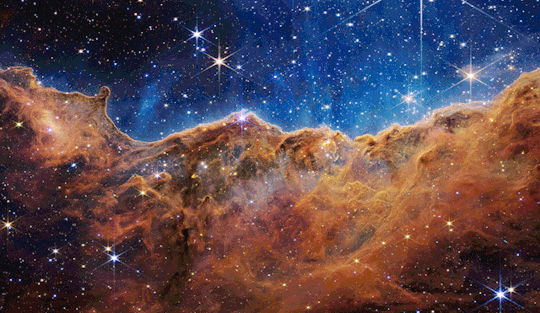
‘THE UNIVERSE AS NOBODY HAS SEEN IT YET’
IMAGES BY NASA, ESA, CSA, AND STSCI

Pictured at top, the “mountains” and “valleys” speckled with glittering stars are actually the edge of a nearby, star-forming region called NGC 3324 in the Carina Nebula. Above, Stephan’s Quintet, a visual grouping of five galaxies, is Webb’s largest image to date.
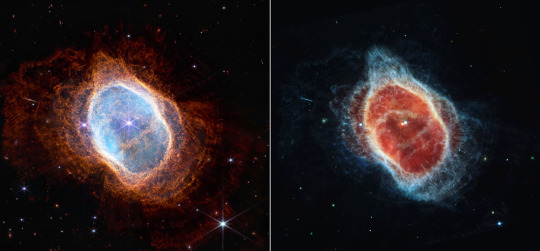
Above, a side-by-side comparison shows the Southern Ring Nebula in near-infrared light, at left, and mid-infrared light.
#space#universe#astronomy#astrophotography#nasa#esa#casa#stsci#carina nebula#stephan's quintet#galaxy#southern ring nebula#webb space telescope#national geographic
88 notes
·
View notes
Text
The Southern Pinwheel Galaxy

The Southern Pinwheel galaxy—also known as M82—is ablaze with star formation. Hundreds of thousands of stars live and die in clusters in the spiral arms. This Hubble image unveils a tapestry of the drama spread across 50,000 light-years. Credit: NASA, ESA.
#Hubble Space Telescope#Hubble#nasa#esa#stsci#pinwheel#galaxy#Star formation#space#Astronomy#astrophotography#astrophysics#universe#science#stem#pink
4 notes
·
View notes
Video
Hubble Data Archive
Jan 1998
Archived Web Page
1 note
·
View note
Photo
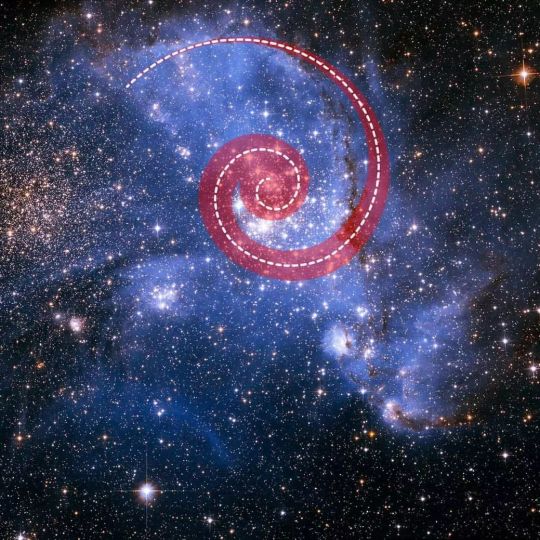
👉💠The massive #star cluster NGC 346, located in the Small Magellanic Cloud, has long intrigued #astronomers with its unusual shape. Now researchers using two separate methods have determined that this shape is partly due to stars and gas spiraling into the center of this cluster in a river-like motion. The red spiral superimposed on NGC 346 traces the movement of stars and gas toward the center. Scientists say this spiraling motion is the most efficient way to feed star formation from the outside toward the center of the #cluster. Credits: Illustration: #NASA, #ESA, Andi James (#STScI) . . . #Magicofscience #WeLoveTheUniverse https://www.instagram.com/p/CiSS2eGs1L0/?igshid=NGJjMDIxMWI=
0 notes
Photo

Posted @withregram • @jameswebb_nasa Webb: transforming the ordinary into the extraordinary. ✨🪐 This time, Jupiter reveals itself in a new color scheme through JWST’s Near-Infrared Camera. The first observation features visible auroras that extend to high altitudes above Jupiter's northern and southern poles. Bright waves, swirls, and vortices in Jupiter's atmosphere are easily visible on the second and third pictures. • Processing: Ricardo Hueso (UPV/EHU) & Judy Schmidt #Jupiter #NIRCam #PHANGS #STScI #Webb #WebbSeesFarther #space #universe #science #physics #nature #infrared #solarsystem #telescope #jameswebb #jameswebbspacetelescope #staycurious https://www.instagram.com/p/ChpBMLZuoMO/?igshid=NGJjMDIxMWI=
#jupiter#nircam#phangs#stsci#webb#webbseesfarther#space#universe#science#physics#nature#infrared#solarsystem#telescope#jameswebb#jameswebbspacetelescope#staycurious
0 notes
Text

Credits: NASA, ESA, and F. Summers, J. DePasquale, and D. Player (STScI)
13 notes
·
View notes
Text
Scientists Find Origin-of-Life Molecule in Space for First Time
— By Jess Thomson | August 8, 2023
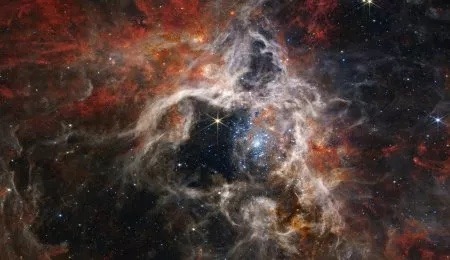
NASA image of the Tarantula Nebula star-forming region taken by Webb’s Near-Infrared Camera. A molecular cloud in interstellar space has been found to contain carbonic acid for the first time. NASA, ESA, CSA, AND STSCI
molecule common to Earth and usually associated with life has been detected in the depths of space by scientists.
Carbonic acid (HOCOOH), which you may know as the chemical that makes your soda fizzy, was discovered lurking near the center of our galaxy in a galactic center molecular cloud named G+0.693-0.027, a study published in The Astrophysical Journal revealed.
This marks the third time that carboxylic acids—this class of chemicals, often thought to be some of the building blocks of life—have been detected in space, after acetic acid and formic, and the first time that an interstellar molecule has been found to contain three or more oxygen atoms.
"Our observations have allowed us to know that carbonic acid, which until now had remained invisible to our eyes, is relatively abundant in space, which makes it an essential piece to understand the interstellar chemistry of carbon and oxygen, two of the fundamental chemical elements in any prebiotic process," Víctor M. Rivilla, a researcher at the Spanish Center for Astrobiology and co-author of the study, told German broadcaster Deutsche Welle (DW).
"This result confirms that the path we have chosen is the right one to search for, and detect more molecules that we suspect were key to the appearance of life on our planet," he concluded.
Carboxylic acids are a type of organic compound characterized by a carbon (C) atom doubly bonded to an oxygen (O) atom and singly bonded to a hydroxyl group (―OH). Carbonic acid in particular is formed when CO2 is dissolved in water, meaning that it is present in increased concentrations in our seas due to CO2 in the atmosphere.
Many theories as to how life on Earth evolved suggest that primitive life may have emerged from a primordial soup of chemicals when our planet was very young. Some have suggested that these chemicals, including carboxylic acids, may have arrived on Earth from space, traveling via comets and meteorites to the forming planet.
Carbonic acid has been previously detected on other astronomical bodies, including the icy moons of Jupiter, in some meteorites and comets, and even on Mars and Mercury, but until now, has not been seen in interstellar space.
The authors explained that the discovery of these more complex molecules in the interstellar medium may reveal clues about the origins of our planet and the life upon it.
"The presence of prebiotic COMs within extraterrestrial material thus firmly suggests the existence of carboxylic acids of increasing complexity in the ISM (interstellar medium), including amino acid–related species. Within this context, considerable efforts have been devoted to hunting for other acids, such as propenoic or acrylic acid, propanoic acid, cyanoacetic acid, glycolic acid, hydantoic acid, and glycine, whose identification in the [interstellar medium] remains elusive."
#Tech & Science#Origion | Life Molecule#Space#NASA | ESA | CSA | STSCI#Tarantula Nebula#Corbonic Acid (HOCOOH)#Astrobiology#Víctor M. Rivilla#Deutsche Welle (DW)#CO2#Carboxylic Acid#Moon | Jupiter | Mars | Mercury#Earth#Prebiotic COMs#ISM (Interstellar Medium)#Acids: Acrylic | Propanoic | Cyanoacetic | Glycolic | Hydantoic | Glycine
0 notes
Photo
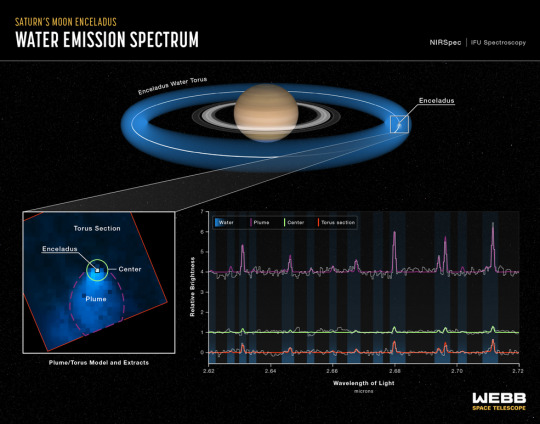


NASA'nın James Webb Uzay Teleskobu'nu kullanan araştırmacılar, Satürn'ün uydusu Enceladus'tan yaklaşık 6.000 milden (Los Angeles, California ile Buenos Aires, Arjantin arasındaki mesafe) yayılan bir su buharı bulutu tespit etti. Bu kadar geniş bir mesafede böyle bir su emisyonunun ilk kez görülmesinin yanı sıra Webb, bilim insanlarına ilk kez bu emisyonun tüm Satürn sistemi için su kaynağını nasıl beslediğine doğrudan bir bakış sunuyor. onun halkaları.
Dünya'nın yaklaşık yüzde dördü büyüklüğünde, sadece 313 mil genişliğinde bir okyanus dünyası olan Enceladus, Dünya'nın ötesinde yaşam arayışında güneş sistemimizdeki en heyecan verici bilimsel hedeflerden biridir. Ay'ın buzlu dış kabuğu ile kayalık çekirdeği arasına sıkıştırılmış, küresel bir tuzlu su deposudur. Gayzer benzeri volkanlar, ayın yüzeyinde gayri resmi olarak 'kaplan çizgileri' olarak adlandırılan yarıklardan buz parçacıkları, su buharı ve organik kimyasallar püskürtür.
#NASA ESA CSA STScI Leah Hustak (STScI)#NASA ESA CSA STScI ve G. Villanueva (NASA'nın Goddard Uzay Uçuş Merkezi). Görüntü İşleme: A. Pagan (STScI).#teşekkürler
0 notes
Text
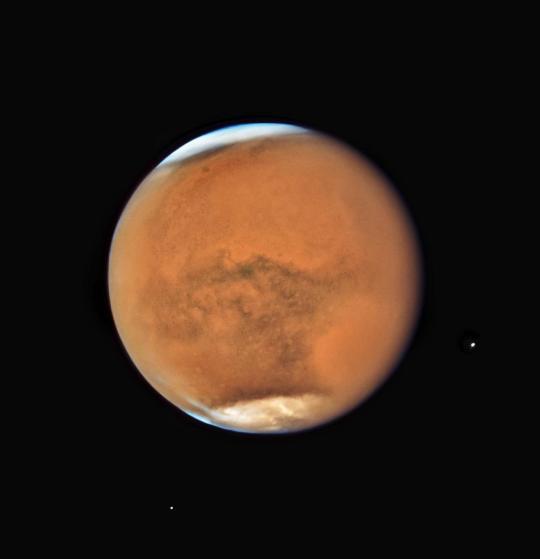
Stormy Mars in opposition in 2018
Credits: NASA, ESA, and STScI
3K notes
·
View notes
Text
Un pequeño polvo, un universo de posibilidades: Un estudio detallado del potencial del telescopio Webb
Esta imagen de la nebulosa de Orión, el punto más brillante de la espada de la constelación de Orión, muestra moléculas ricas en carbono llamadas hidrocarburos aromáticos policíclicos (HAP) como volutas de rojo y naranja. Esta imagen fue capturada mediante un equipo de los telescopios Hubble y Spitzer, dos predecesores del Telescopio Espacial James Webb. “Con Webb podremos ver muchos más…

View On WordPress
0 notes
Text

Stellar spire in the Eagle Nebula.
Credit: NASA, ESA, and The Hubble Heritage Team (STScI/AURA).
#space#science#nature#astronomy#Universe#Cosmos#Astrophotography#NASA#night sky#stars#astro community#outer space#astrophysics#cosmology#nebula#hubble space telescope
670 notes
·
View notes
Photo

#incredible Posted @withregram • @jameswebb_nasa Webb: transforming the ordinary into the extraordinary. ✨🪐 This time, Jupiter reveals itself in a new color scheme through JWST’s Near-Infrared Camera. The first observation features visible auroras that extend to high altitudes above Jupiter's northern and southern poles. Bright waves, swirls, and vortices in Jupiter's atmosphere are easily visible on the second and third pictures. • Processing: Ricardo Hueso (UPV/EHU) & Judy Schmidt #Jupiter #NIRCam #PHANGS #STScI #Webb #WebbSeesFarther #jwst #jameswebb #jameswebbspacetelescope #infrared #telescope #nature #space #universe #solarsystem https://www.instagram.com/p/ChpANCLOyft/?igshid=NGJjMDIxMWI=
#incredible#jupiter#nircam#phangs#stsci#webb#webbseesfarther#jwst#jameswebb#jameswebbspacetelescope#infrared#telescope#nature#space#universe#solarsystem
0 notes
Text

0 notes